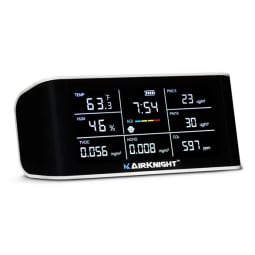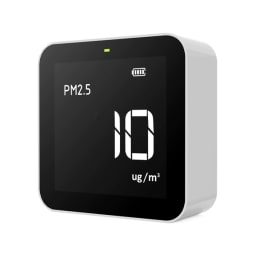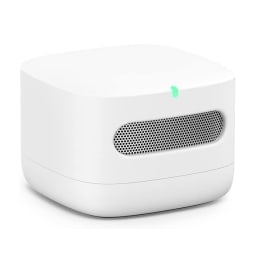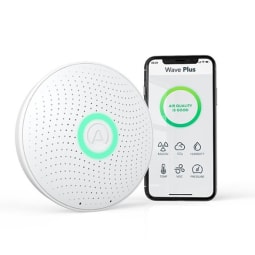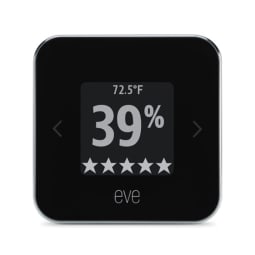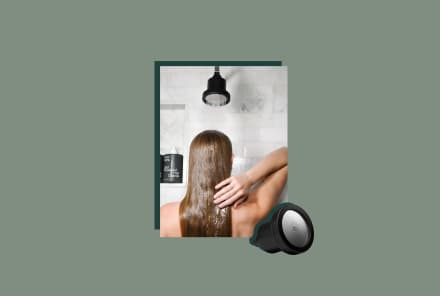Advertisement
The 6 Best Indoor Air Quality Monitors Of 2023 + Signs Of Poor Indoor Air Quality


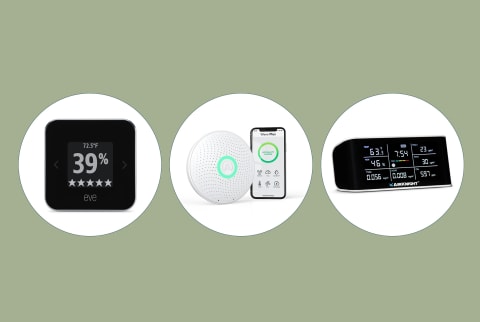
- Best portable: AIRKNIGHT Portable Air Quality Monitor
- Best design: Temptop M10 Rechargeable Air Quality Tester
- Best smart: Amazon Smart Quality Monitor
- Best versatile: Temptop 1000S Indoor Air Quality Monitor
- Best with app: Airthings 2930 Wave Plus
- Best rechargeable: Eve Room Indoor Air Quality Monitor
Research indicates that indoor air can be up to two to five times more concentrated with pollutants than outdoor air1—and if you consider the fact that most Americans spend approximately 90% of their time indoors1, this is kind of a big deal. The best indoor air quality monitors keep tabs on how clean the air in your home is, so you can protect your own health, too.
Exposure to less-than-ideal indoor air has been linked to respiratory and cardiovascular diseases and can have negative cognitive effects. The first step in cleaning up your air (and your health!) is understanding just how polluted it might be.
There are a few key signs that may indicate your air quality is suffering, but these handy monitors take the guesswork out.
How does poor indoor air quality affect health?
Gráinne Cunniffe, science lead at Allergy Standards Ltd., explains that poor indoor air quality can have quite a few negative effects on health.
“Even the healthiest people can experience negative effects from poor indoor air quality,” Cunniffe says. “Airborne triggers can cause irritation to the eyes, nose, and throat, and cause headaches, dizziness, and fatigue.”
Cunniffe shares that additional symptoms can include worsened allergies, coughing, wheezing, sneezing, shortness of breath, and even asthma attacks.
According to the National Institute of Environmental Health Sciences, short- and long-term exposure to indoor air pollution has been linked to respiratory disease, heart disease, and even cancer.
All this considered, keeping an eye on your home's air quality is crucial in maintaining optimal health.
What causes poor indoor air quality?
Per Cunniffe, there is a wide range of pollutants that can cause the air quality inside your home to take a nosedive.
One such pollutant is particulate matter (PM), which Cunniffe explains "is made up of tiny particles like dust, smoke, and allergens that can remain suspended in the breathing zone in the air." She adds that common allergens and triggers found around the home, such as dust mites, pet dander, and candle or tobacco smoke can also negatively impact indoor air quality.
“Another known contributor to poor indoor air quality are Volatile Organic Compounds (VOCs), which are chemicals that are released into the air from various products and activities,” Cunniffe says. “Installing building materials, flooring, paint, and even cooking can emit VOCs, so it is important to consciously choose low VOC products.”
Dr. Anisha Arora, a pulmonary critical care physician with Memorial Hermann in Houston, TX, points out that some causes may be more unexpected.
“For example, woodworking or ceramics and allergens from pet bird feces that can get into someone's lungs when they are constantly in close quarters with the allergen when cleaning the birdcage,” Arora shares.
Arora says a good ventilation system, regularly changing your air conditioning filters, and investing in a portable air filter may all be helpful in improving indoor air quality.
“I would also recommend checking the house for humidity or dampness as mold can be present, and that can lead to lung problems for many people,” she adds. “Good respiratory hygiene would also include regularly cleaning your environment and dusting it down.”
Signs of poor indoor air quality:
Cunniffe says persistent respiratory symptoms, such as unusually severe allergy symptoms and asthma, unpleasant home odors, visible mold or mildew, excessive dust, and general physical discomfort, can all be signs of poor indoor air quality.
“These symptoms may indicate the presence of pollutants, stagnant air, inadequate air filtration, or excessive moisture,” she explains. “Understanding what is contributing to your poor indoor air quality by identifying the signs can help answer which certified products may help the most, such as dehumidifiers, vacuum cleaners, and HVAC filters.”
How to choose the best indoor air quality monitor
It's important to choose an indoor air quality monitor that fits your lifestyle needs. “We recommend choosing an air quality monitor that aligns with your environment, needs, and concerns since there are different types of monitors that test for specific pollutants,” Cunniffe says.
“For example, there are air quality monitors that specifically measure temperature and humidity, while others are designed to measure fine particulate matter, VOCs or carbon dioxide (CO2) levels.”
Keeping this in mind, Cunniffe suggests considering the following:
Accuracy: Be sure to choose an air quality monitor that has a reputation for sensitivity and produces accurate, precise readings.
User-friendly interface: A monitor with a simple-to-use interface and design will save you time and prevent frustration.
Battery life: “Look for models with a good battery life for continuous monitoring and alerts or notifications for timely awareness of changes in air quality,” Cunniffe suggests.
Special features: Many monitors come with special features. Cunniffe recommends choosing a model that can be easily integrated with other systems you already have around the home (such as an Amazon Alexa or Google Home), for convenience and accessibility.
Third-party testing: Certified or third-party tested products may be higher quality and more reliable.
How we picked:
Features: Indoor air quality monitors vary in what features each has. We called attention to unique details each has to help you along your decision-making process.
Quality: We included high-quality products made from trustworthy brands. High-quality products often last longer, which can help save you money in the long run.
Ratings: Ratings and reviews helped give us a better idea of what people like about each pick. Cons allowed us to paint a picture of what people may not be a fan of.
Expert Advice: We kept expert tips and insight in mind when deciding which indoor air quality monitors to include.
Our picks for the best indoor air quality monitor
Pros:
- Perfect for on the go
- Comes with an instructional video
- Detects eight kinds of air pollution
- Sleek LCD screen
Cons:
- Some find it tricky to recalibrate readings
Measures:
CO2, VOCs, formaldehyde, AQI, PM2.5, PM10 dust particles, & moreDimensions:
7.5” x 3.1” x 1.4”Featuring an eye-catching tabletop design, this unit works hard to detect and monitor nine pollutants, including VOCs, PM2.5, dust particles, and more. It even will alert you if carbon monoxide is in the air.
Setup is simple and fast (no Wi-Fi needed), and an instruction video is included in case you get stuck.
Small and portable, this device can be effortlessly moved around the home or taken with you while traveling. The battery is long-lasting and rechargeable, too.
It's lauded for its sleek display, simple setup, and thorough measurements. Just note, there is no accompanying app (which could be a good thing, if you want something a bit less tech-savvy).
Pros:
- Highly accurate readings
- High-quality feel
- Easy to use
Cons:
- Short battery life
Measures:
PM2.5, AQI, HCHO, and TVOCDimensions:
3.2” x 3.2” x 1.2”If you’re interested in a rechargeable air quality monitor that comes with a sleek design, this Temptop pick is for you. It’s equipped with a highly sensitive PM2.5 laser sensor and a British Dart formaldehyde (HCHO) sensor, and has a 3-color LED light indicator that changes shade based on the air quality: Green is good, yellow is fair, and red is poor.
You don’t have to worry about any confusing interfaces with this unit: Each device boasts a single multi-purpose button, so it's a breeze to operate (and it's portable, too).
Hundreds of Amazon shoppers have given this pick a perfect five-star ratingn. Not only is it super easy to use, but it also has a sleek, design-forward interface that adds a nice touch. Reviewers say the readings are right on par with more expensive devices.
Advertisement
Pros:
- Can be connected to Alexa
- Color-coded LED for quick read
- Simple setup
Cons:
- No screen display on monitor
Measures:
VOCs, CO, PM2.5, humidity, temperatureDimensions:
2.5" x 2.5" x 1.7"A smart air quality monitor can make keeping tabs on your indoor air quality so much easier. This one boasts a straightforward design, so you don’t have to worry about any confusing buttons.
The monitor can be paired with compatible Alexa devices (for voice control) and comes with an app to conveniently check the air quality score if you’re not in the same room as the monitor. In fact, you can even get alerts sent to your phone or Echo device.
This pick measures various air quality elements, including PM, VOCs, CO, humidity, and temperature. You can also connect this unit to your other Alexa-compatible devices, such as air purifiers and dehumidifiers, to automatically turn on if your air quality rating dips below a certain level.
Reviewers say this device is a game-changer, particularly when performing basic tasks around the house (like cooking), which you might not have realized could have an impact on air quality.
Best versatile: Temptop 1000S Indoor Air Quality Monitor
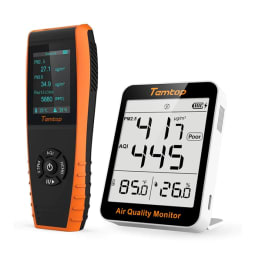
Pros:
- One of the most advanced monitors on the market
- Long sensor life
- Easy-to-read screen
- Rechargeable battery
Cons:
- Bulkier design
Measures:
PM2.5 and PM10, (HCHO), VOC, humidity, temperature, AQIDimensions:
2.6” x 1.3” x 6.9”Small but mighty, this handheld monitor clocks in at just over a pound and can be easily moved from room to room. Each unit has an industrial-grade laser particle sensor that lasts up to 20,000 hours.
This pick also features a large, easy-to-read screen with a six-level color indicator to notify you of the current air quality quickly.
Another extremely accurate monitor, this device gets a ton of praise from Amazon shoppers for its ability to measure air quality and assess performance of air purifiers.
Advertisement
Pros:
- Bluetooth-connected
- 1.5-year average battery life
- Compatible with Alexa and Google Assistant
- Also senses radon
Cons:
- App can be glitchy
Measures:
Radon, CO2, VOCs, humidity, temperature, air pressureDimensions:
4.75” x 4.75” x 1.4”This highly popular model measures pollutants in the air, such as VOCs from cleaning products and cooking fumes, and can also detect radon.
Those who suffer from pollen allergies will also be happy to hear that the Airthing Wave Plus sensors can also measure pollen, which may help determine whether you should open or close your windows.
An accompanying app gives you a full air quality breakdown—and, if you want an even quicker reading, simply wave your hand in front of the sensor and it will respond with a color indicator (green is good, yellow is fair, red is poor).
This monitor is compatible with both Alexa and Google Assistant and has over 1,5000 perfect five-star ratings on Amazon. People love this model for its long battery life, simple setup, and the easy-to-use app.
Pros:
- Can be charged via USB
- Comes with smartphone app
- Long battery life
- Compact
Cons:
- Screen could be brighter
Measures:
VOCs, temperature, humidityDimensions:
0.5” x 2.1” x 2.1”Rechargeable with long battery life? Check. Smartphone app? Check. Compact size? Check.
The Eve Room indoor air quality monitor may be tiny in size, but its extremely accurate in monitoring VOCs, temperature, and humidity.
This air sensor can also easily be integrated into your Apple HomeKit, meaning you can access this pick’s info via your iPhone, iPad, and Apple Watch.
It features a convenient rechargeable battery (each full charge should last you around six weeks) and is Bluetooth-enabled. You should be able to get it up and running in mere minutes.
The monitor is applauded for its compact size, long battery life, and the fact that it has an app to check readings more quickly. Plus, the design is aesthetically pleasing, which isn't always the case with these devices.
Advertisement
Comparing the best indoor air quality monitors
| Product | Price | Measures | Dimensions |
|---|---|---|---|
| AIRKNIGHT Portable Air Quality Monitor | $135 | CO2; VOCs; formaldehyde; AQI; PM2.5; PM10 dust particles | 7.5” x 3.1” x 1.4” |
| Temptop M10 Rechargeable Air Quality Tester | $90 | PM2.5; AQI; HCHO; TVOC | 3.2” x 3.2” x 1.2” |
| Amazon Smart Quality Monitor | $47 | VOCs; CO; PM2.5; humidity; temperature | 2.5" x 2.5" x 1.7" |
| Temptop 1000S Indoor Air Quality Monitor | $176 | PM2.5; PM10; HCHO; VOC; humidity; temperature; AQI | 2.6” x 1.3” x 6.9” |
| Airthings 2930 Wave Plus | $205 | Radon; CO2; VOCs; humidity; temperature; air pressure | 4.75” x 4.75” x 1.4” |
| Eve Room Indoor Air Quality Monitor | $100 | VOCs; temperature; humidity | 0.5” x 2.1” x 2.1” |
FAQ
Is it worth buying an indoor air quality monitor?
Yes. An accurate indoor air quality monitor detects and measures pollutants in your home. This knowledge can help you make the appropriate changes to your environment, which can then positively affect your health.
What is AQI?
AQI stands for Air Quality Index. This index is used to measure the quality of air.
What are the symptoms for poor air quality in the home?
Gráinne Cunniffe, science lead at Allergy Standards Ltd., says persistent respiratory symptoms, such as unusually severe allergy symptoms and asthma, unpleasant home odors, visible mold or mildew, excessive dust, and general physical discomfort, can all be signs of poor indoor air quality.
The takeaway
The best indoor air quality monitors detect and measure a long list of pollutants, such as VOCs and PM2.5. Knowing more about the quality of your indoor air can help you make necessary adjustments that can benefit your health. If you’re interested in learning more about the importance of good air quality, be sure to check out our guide for the best air purifiers of 2023 and the best air purifiers for smoke.
Meet The Experts
5 Sources
- https://www.epa.gov/report-environment/indoor-air-quality
- https://www.epa.gov/air-trends/particulate-matter-pm25-trends
- https://www.epa.gov/air-trends/particulate-matter-pm10-trends
- https://www.epa.gov/indoor-air-quality-iaq/what-are-volatile-organic-compounds-vocs
- https://pubs.acs.org/doi/10.1021/acs.est.7b01356
Watch Next
Enjoy some of our favorite clips from classes
Enjoy some of our favorite clips from classes
What Is Meditation?
Mindfulness/Spirituality | Light Watkins
Box Breathing
Mindfulness/Spirituality | Gwen Dittmar
What Breathwork Can Address
Mindfulness/Spirituality | Gwen Dittmar
The 8 Limbs of Yoga - What is Asana?
Yoga | Caley Alyssa
Two Standing Postures to Open Up Tight Hips
Yoga | Caley Alyssa
How Plants Can Optimize Athletic Performance
Nutrition | Rich Roll
What to Eat Before a Workout
Nutrition | Rich Roll
How Ayurveda Helps Us Navigate Modern Life
Nutrition | Sahara Rose
Messages About Love & Relationships
Love & Relationships | Esther Perel
Love Languages
Love & Relationships | Esther Perel
